GeoTools,GIS的另一个基础设施!
About GeoTools
GeoTools is an open source (LGPL) Java code library which provides standards compliant methods for the manipulation of geospatial data, for example to implement Geographic Information Systems (GIS). The GeoTools library implements Open Geospatial Consortium (OGC) specifications as they are developed.
走进 GeoTools
GeoTools
的架构图如下,我们了解
GeoTools
的架构以及各个jar包所构成的库栈,能够帮助我们更加清晰的了解和学习
GeoTools
的各个模块,并且还能够帮助我们在项目里面选择适合我们的库。
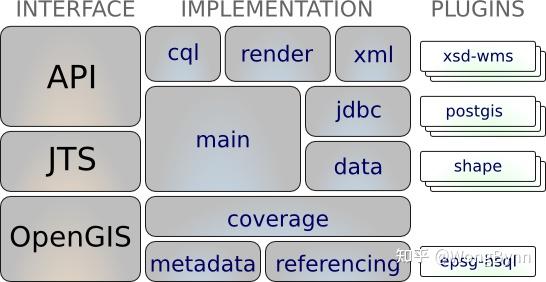
这张架构图遵循了软件工程领域里面架构图设计标准,由下而上,第一层是基础设施,上层建筑依赖于基础设施。
比如:你如果想使用
Referencing
模块里的
gt-opengis
,
gt-referencing
,
gt-metadata
内容,那么当你使用
data
模块的时候,
gt-main
,
jts
,
gt-opengis
,
gt-referencing
,
gt-opengis
,
gt-metadata
,上面
Referencing
的内容也是会引用到的。
GeoTools
常用模块的功能列表:
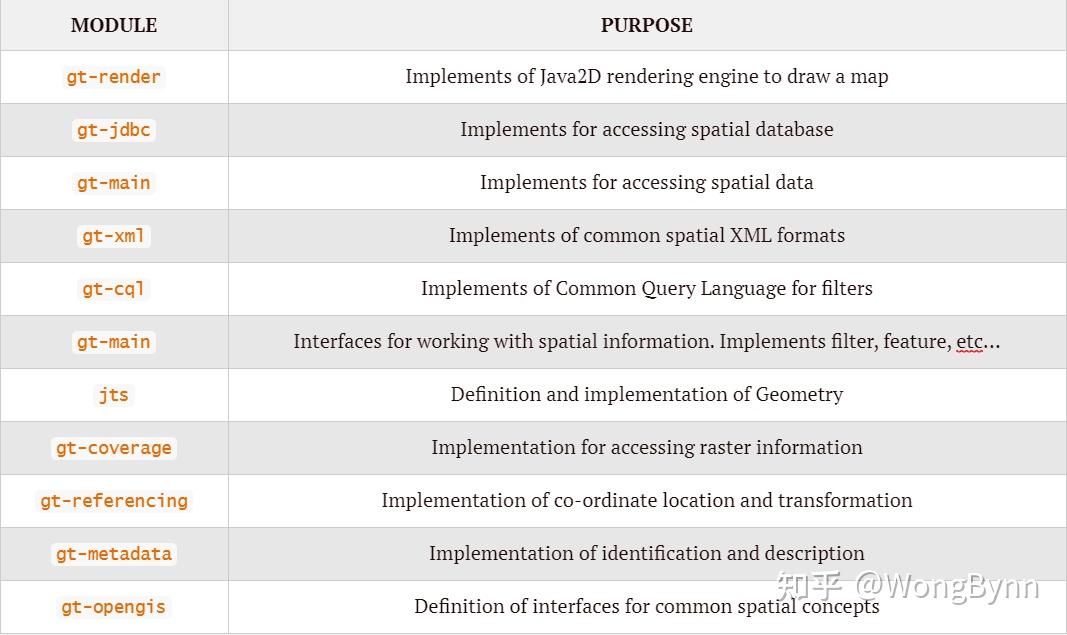
GeoTools
提供插件来支持额外的数据格式、不同的坐标参考系统权限等等。
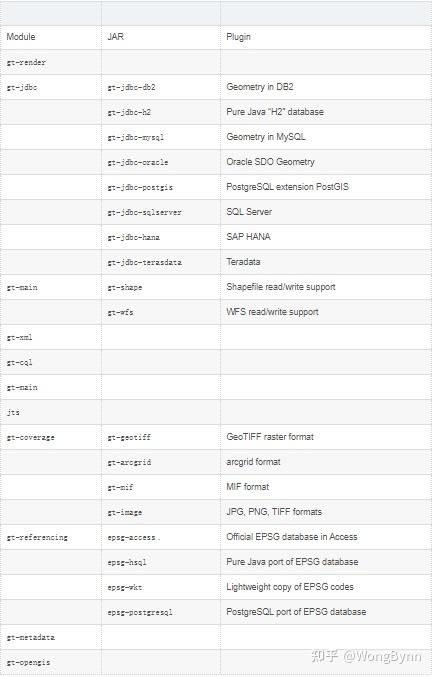
除此之外,
GeoTools
团队在
GeoTools
的基础上实现了一些扩展,当然了,这些扩展是为了提供一些额外的功能。这些扩展是相互独立的,我们可以直接在项目中使用。
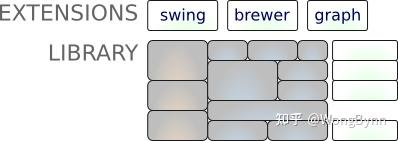
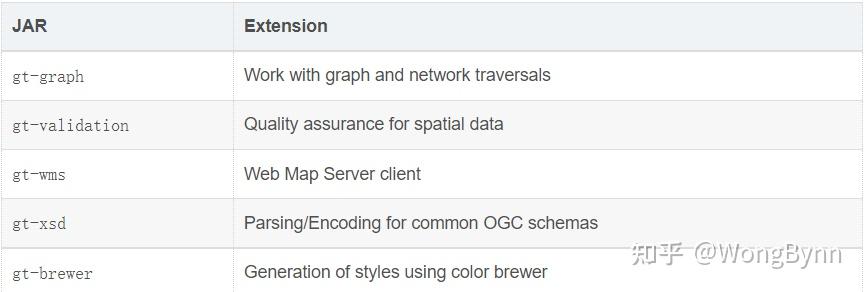
GeoTools
团队
为了支持
GeoTools
中的XML模块,将几个XML模式打包成JAR形式,方便开发者进行调用。
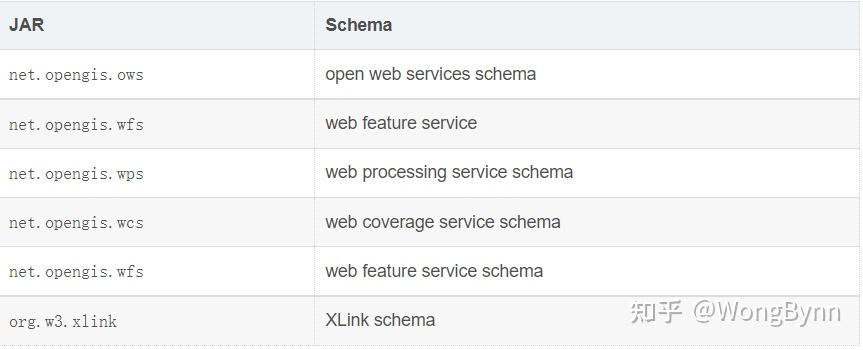
XSD解析器通过一系列XSD插件使用这些工具。这些插件指示如何使用Eclipse XSD库解析和编码额外的内容来解析XML模式文档,并提供“绑定”,显示如何解析和编码Java类,如String、Date、URL和Geometry。
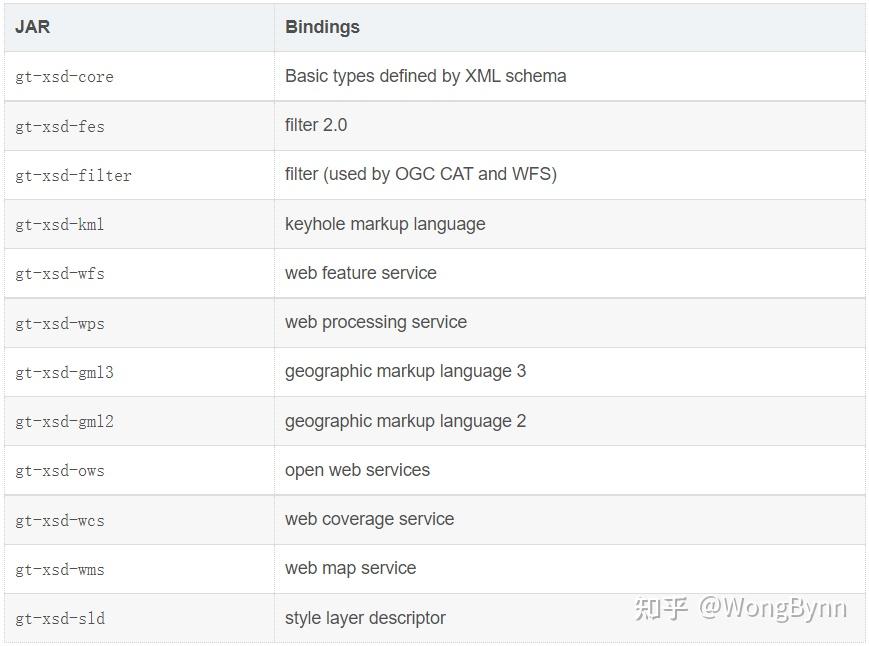
以下是
GeoTools
不支持的扩展,你也可以使用Maven下载它们来使用。
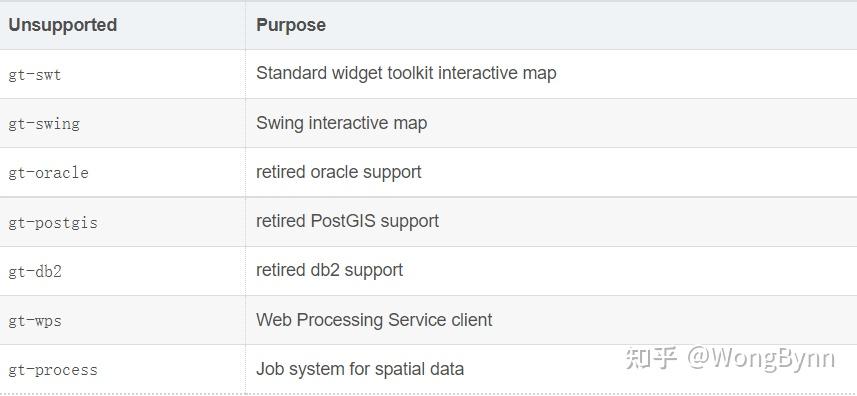
牛刀小试
- 在POM文件中,首先添加以下内容:
<properties>
<project.build.sourceEncoding>UTF-8</project.build.sourceEncoding>
<geotools.version>24-SNAPSHOT</geotools.version>
</properties>
-
然后在POM文件的
<repositories>标签中,添加以下依赖,该依赖是GeoTools官方的依赖远程仓库位置:
<repositories>
<repository>
<id>osgeo</id>
<name>OSGeo Release Repository</name>
<url>https://repo.osgeo.org/repository/release/</url>
<snapshots><enabled>false</enabled></snapshots>
<releases><enabled>true</enabled></releases>
</repository>
<repository>
<id>osgeo-snapshot</id>
<name>OSGeo Snapshot Repository</name>
<url>https://repo.osgeo.org/repository/snapshot/</url>
<snapshots><enabled>true</enabled></snapshots>
<releases><enabled>false</enabled></releases>
</repository>
</repositories>
- 在POM文件中添加以下依赖:
<dependencies>
<dependency>
<groupId>junit</groupId>
<artifactId>junit</artifactId>
<version>4.13.1</version>
<scope>test</scope>
</dependency>
<dependency>
<groupId>org.geotools</groupId>
<artifactId>gt-shapefile</artifactId>
<version>${geotools.version}</version>
</dependency>
<dependency>
<groupId>org.geotools</groupId>
<artifactId>gt-swing</artifactId>
<version>${geotools.version}</version>
</dependency>
<!-- https://mvnrepository.com/artifact/org.locationtech.jts/jts-core -->
<dependency>
<groupId>org.locationtech.jts</groupId>
<artifactId>jts-core</artifactId>
<version>1.16.1</version>
</dependency>
<!-- https://mvnrepository.com/artifact/org.geotools/gt-main -->
<dependency>
<groupId>org.geotools</groupId>
<artifactId>gt-main</artifactId>
<version>22-RC</version>
</dependency>
</dependencies>
-
在你的Spring Boot工程中新建
QuickStrat类,并添加以下代码:
import org.geotools.data.FileDataStore;
import org.geotools.data.FileDataStoreFinder;
import org.geotools.data.simple.SimpleFeatureSource;
import org.geotools.map.FeatureLayer;
import org.geotools.map.Layer;
import org.geotools.map.MapContent;
import org.geotools.styling.SLD;
import org.geotools.styling.Style;
import org.geotools.swing.JMapFrame;
import org.geotools.swing.data.JFileDataStoreChooser;
import java.io.File;
* @Author Wangb
* @Date 20/11/2021 下午6:54.
* @Description
public class Quickstart {
* GeoTools Quickstart demo application. Prompts the user for a shapefile and displays its
* contents on the screen in a map frame
public static void main(String[] args) throws Exception {
// display a data store file chooser dialog for shapefiles
File file = JFileDataStoreChooser.showOpenFile("shp", null);
if (file == null) {
return;
FileDataStore store = FileDataStoreFinder.getDataStore(file);
SimpleFeatureSource featureSource = store.getFeatureSource();
// Create a map content and add our shapefile to it
MapContent map = new MapContent();
map.setTitle("Quickstart");
Style style = SLD.createSimpleStyle(featureSource.getSchema());
Layer layer = new FeatureLayer(featureSource, style);
map.addLayer(layer);
// Now display the map
JMapFrame.showMap(map);
-
在该网站
http://www.naturalearthdata.com/downloads/50m-cultural-vectors/,根据自己的喜好来下载一个矢量数据文件。
在下图的窗口中勾选你刚才下载、并解压文件后的位置。
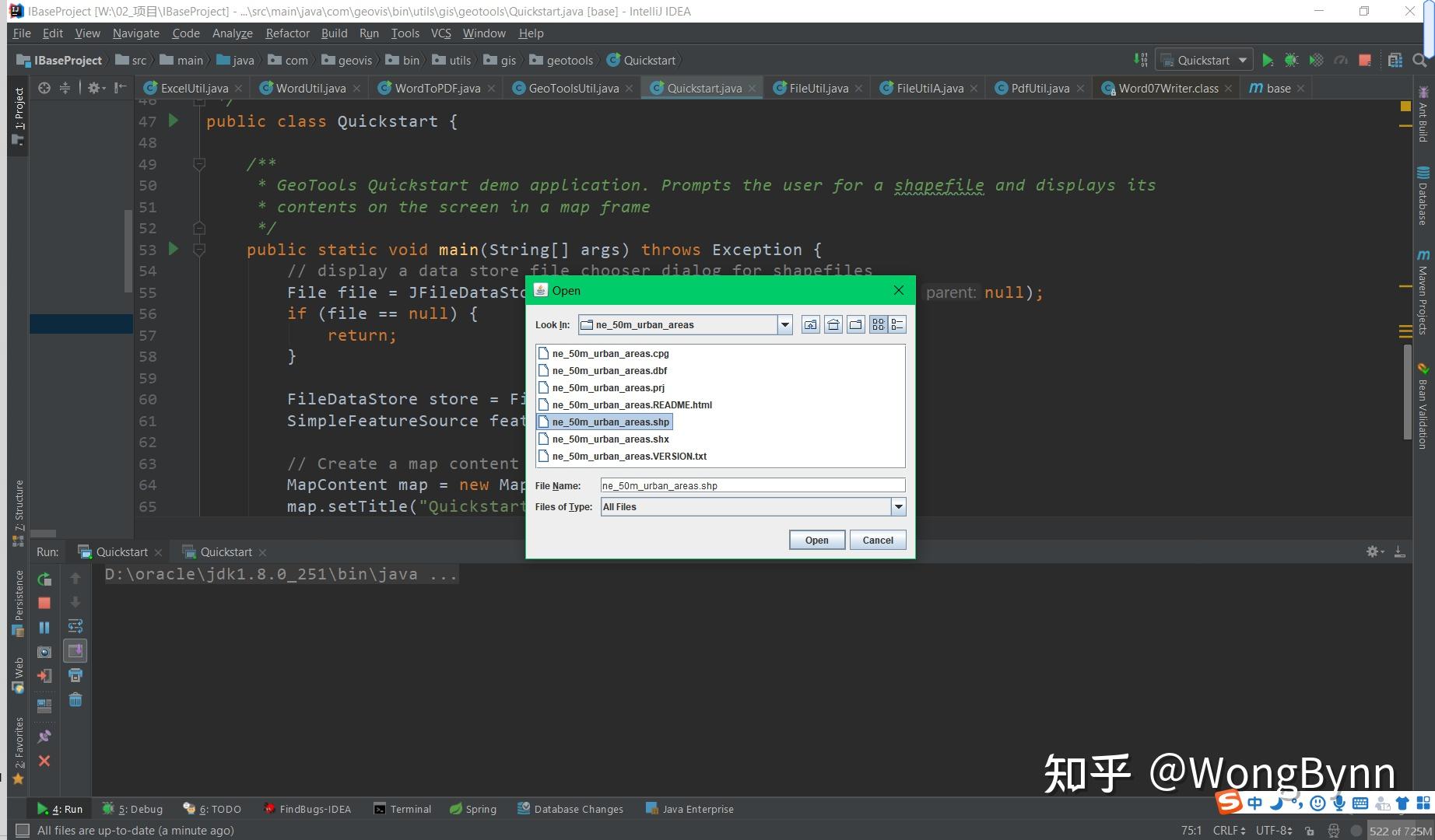
- 接下来就会自动弹出一个窗口,里面展示了你刚才下载的矢量文件,如下图:

以上是我们对
GeoTools
的快速启动案例的学习。
CSV转换SHP教程
-
在该地址下载
location.csv文件:
http:// docs.geotools.org/stabl e/userguide/_downloads/d4bcf8751cc3f33a9fb673902a960e53/locations.csv
- 在你的IDE中键入以下代码:
package com.geovis.bin.utils.gis.geotools;
import com.vividsolutions.jts.geom.Coordinate;
import com.vividsolutions.jts.geom.GeometryFactory;
import com.vividsolutions.jts.geom.Point;
import org.geotools.data.DataUtilities;
import org.geotools.data.DefaultTransaction;
import org.geotools.data.Transaction;
import org.geotools.data.collection.ListFeatureCollection;
import org.geotools.data.shapefile.ShapefileDataStore;
import org.geotools.data.shapefile.ShapefileDataStoreFactory;
import org.geotools.data.simple.SimpleFeatureCollection;
import org.geotools.data.simple.SimpleFeatureSource;
import org.geotools.data.simple.SimpleFeatureStore;
import org.geotools.feature.SchemaException;
import org.geotools.feature.simple.SimpleFeatureBuilder;
import org.geotools.geometry.jts.JTSFactoryFinder;
import org.geotools.swing.data.JFileDataStoreChooser;
import org.opengis.feature.simple.SimpleFeature;
import org.opengis.feature.simple.SimpleFeatureType;
import javax.swing.*;
import java.io.*;
import java.util.ArrayList;
import java.util.HashMap;
import java.util.List;
import java.util.Map;
* This example reads data for point locations and associated attributes from a comma separated text
* (CSV) file and exports them as a new shapefile. It illustrates how to build a feature type.
* <p>Note: to keep things simple in the code below the input file should not have additional spaces
* or tabs between fields.
* @Author Wangb
* @Date 20/11/2021 下午9:32.
* @Description
public class Csv2Shape {
public static void csv2Shape() throws IOException, SchemaException, ClassNotFoundException, UnsupportedLookAndFeelException, InstantiationException, IllegalAccessException {
// Set cross-platform look & feel for compatability
UIManager.setLookAndFeel(UIManager.getCrossPlatformLookAndFeelClassName());
File file = JFileDataStoreChooser.showOpenFile("csv", null);
if (file == null) {
return;
* We use the DataUtilities class to create a FeatureType that will describe the data in our
* shapefile.
* See also the createFeatureType method below for another, more flexible approach.
final SimpleFeatureType TYPE =
DataUtilities.createType(
"Location",
"the_geom:Point:srid=4326,"
+ // <- the geometry attribute: Point type
"name:String,"
+ // <- a String attribute
"number:Integer" // a number attribute
System.out.println("TYPE:" + TYPE);
* A list to collect features as we create them.
List<SimpleFeature> features = new ArrayList<>();
* GeometryFactory will be used to create the geometry attribute of each feature,
* using a Point object for the location.
GeometryFactory geometryFactory = JTSFactoryFinder.getGeometryFactory();
SimpleFeatureBuilder featureBuilder = new SimpleFeatureBuilder(TYPE);
try (BufferedReader reader = new BufferedReader(new FileReader(file))) {
/* First line of the data file is the header */
String line = reader.readLine();
System.out.println("Header: " + line);
for (line = reader.readLine(); line != null; line = reader.readLine()) {
//skip blank lines
if (line.trim().length() > 0) {
String[] tokens = line.split("\\,");
double latitude = Double.parseDouble(tokens[0]);
double longitude = Double.parseDouble(tokens[1]);
String name = tokens[2].trim();
int number = Integer.parseInt(tokens[3].trim());
/* Longitude (= x coord) first ! */
Point point = geometryFactory.createPoint(new Coordinate(longitude, latitude));
featureBuilder.add(point);
featureBuilder.add(name);
featureBuilder.add(number);
SimpleFeature feature = featureBuilder.buildFeature(null);
features.add(feature);
* Get an output file name and create the new shapefile
File newFile = getNewShapeFile(file);
ShapefileDataStoreFactory dataStoreFactory = new ShapefileDataStoreFactory();
Map<String, Serializable> params = new HashMap<>();
params.put("url", newFile.toURI().toURL());
params.put("create spatial index", Boolean.TRUE);
ShapefileDataStore newDataStore =
(ShapefileDataStore) dataStoreFactory.createNewDataStore(params);
* TYPE is used as a template to describe the file contents
newDataStore.createSchema(TYPE);
* Write the features to the shapefile
Transaction transaction = new DefaultTransaction("create");
String typeName = newDataStore.getTypeNames()[0];
SimpleFeatureSource featureSource = newDataStore.getFeatureSource(typeName);
SimpleFeatureType SHAPE_TYPE = featureSource.getSchema();
* The Shapefile format has a couple limitations:
* - "the_geom" is always first, and used for the geometry attribute name
* - "the_geom" must be of type Point, MultiPoint, MuiltiLineString, MultiPolygon
* - Attribute names are limited in length
* - Not all data types are supported (example Timestamp represented as Date)
* Each data store has different limitations so check the resulting SimpleFeatureType.
System.out.println("SHAPE:" + SHAPE_TYPE);
if (featureSource instanceof SimpleFeatureStore) {
SimpleFeatureStore featureStore = (SimpleFeatureStore) featureSource;
* SimpleFeatureStore has a method to add features from a
* SimpleFeatureCollection object, so we use the ListFeatureCollection
* class to wrap our list of features.
SimpleFeatureCollection collection = new ListFeatureCollection(TYPE, features);
featureStore.setTransaction(transaction);
try {
featureStore.addFeatures(collection);
transaction.commit();
} catch (Exception problem) {
problem.printStackTrace();
transaction.rollback();
} finally {
transaction.close();
// success!
System.exit(0);
} else {
System.out.println(typeName + " does not support read/write access");
System.exit(1);
* Prompt the user for the name and path to use for the output shapefile
* @param csvFile the input csv file used to create a default shapefile name
* @return name and path for the shapefile as a new File object
private static File getNewShapeFile(File csvFile) {
String path = csvFile.getAbsolutePath();
String newPath = path.substring(0, path.length() - 4) + ".shp";
JFileDataStoreChooser chooser = new JFileDataStoreChooser("shp");
chooser.setDialogTitle("Save shapefile");
chooser.setSelectedFile(new File(newPath));
int returnVal = chooser.showSaveDialog(null);
if (returnVal != JFileDataStoreChooser.APPROVE_OPTION) {
// the user cancelled the dialog
System.exit(0);
File newFile = chooser.getSelectedFile();
if (newFile.equals(csvFile)) {
System.out.println("Error: cannot replace " + csvFile);
System.exit(0);
return newFile;
public static void main(String[] args) throws Exception {
csv2Shape();
-
运行该代码,会弹出对话框,需要你选择下载并解压后的
location.csv文件
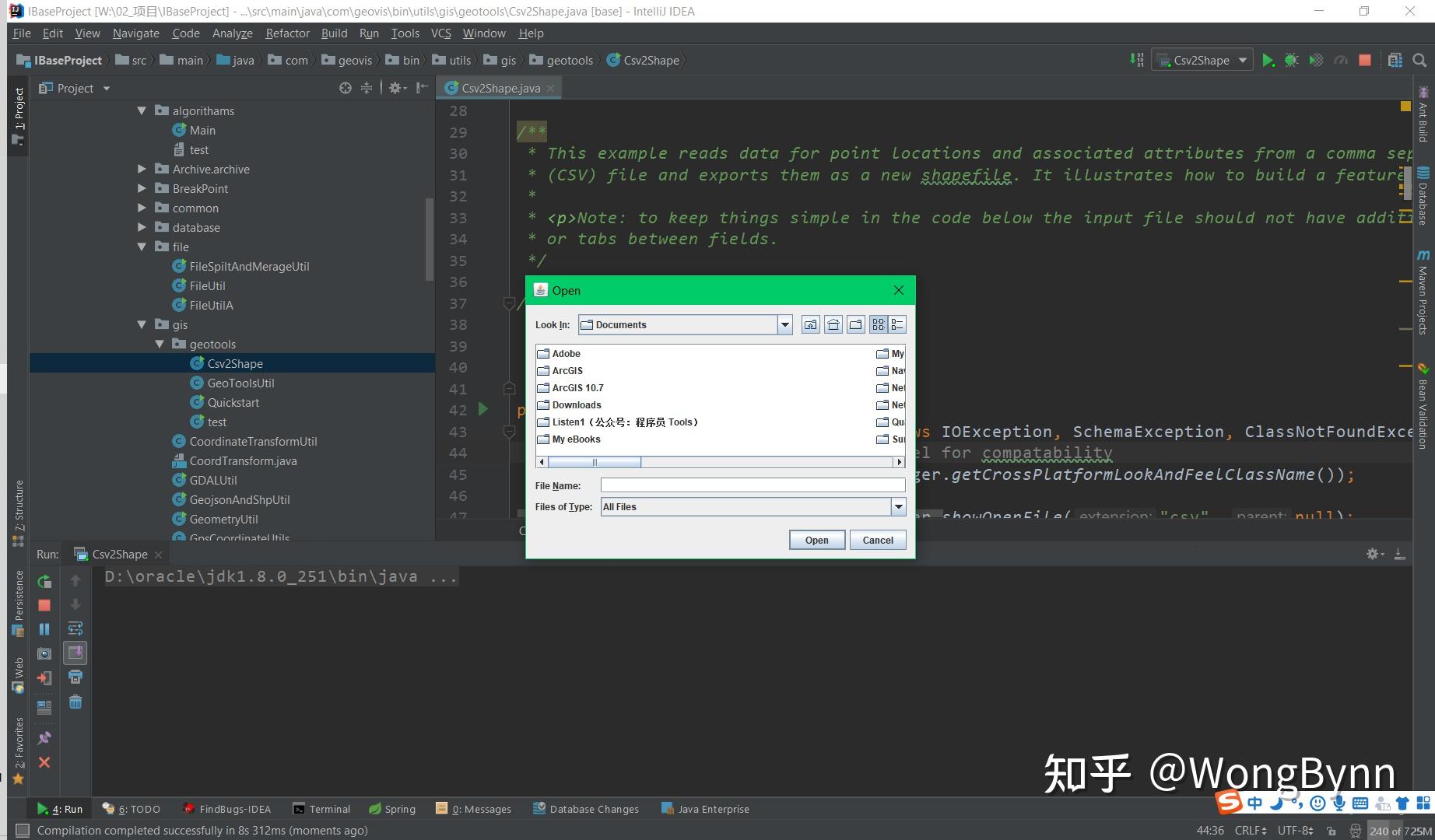
-
选好之后会在同级目录生成
shape file,我们把location.shp文件拖入ArcGIS DeskTop软件中,就可以看到如下界面:
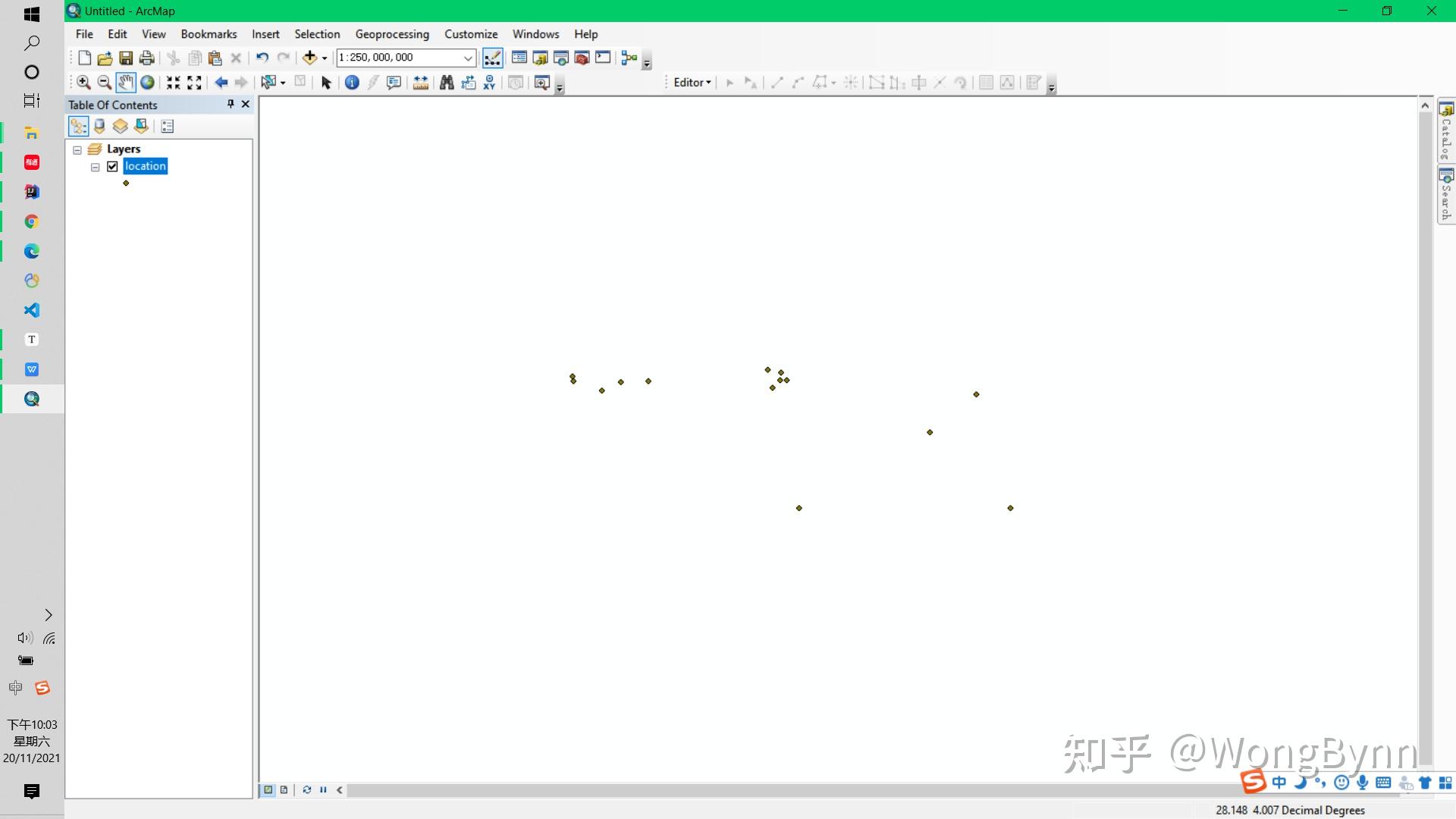
- 至此,我们完成csv至shp文件的转换工作。
从shp文件读取要素集
/**
* 获取shp几何对象集合
* @param fileUrl 文件地址
* @return 几何集合
public static List<Geometry> getGeometryList(String fileUrl) throws IOException {
List<Geometry> geometryList = new ArrayList<>();
ShapefileReader r = null;
try {
r = new ShapefileReader(new ShpFiles(fileUrl), false, false, new GeometryFactory());
while (r.hasNext()) {
Geometry shape = (Geometry) r.nextRecord().shape();
ShapeType shapeType = r.getHeader().getShapeType();
double x1 = r.getHeader().maxX();
double y1 = r.getHeader().maxY();
double x2 = r.getHeader().minX();
double y2 = r.getHeader().minY();
geometryList.add(shape);
} catch (Exception e) {
if (r != null) {
r.close();
e.printStackTrace();
return geometryList;
运行结果如下:
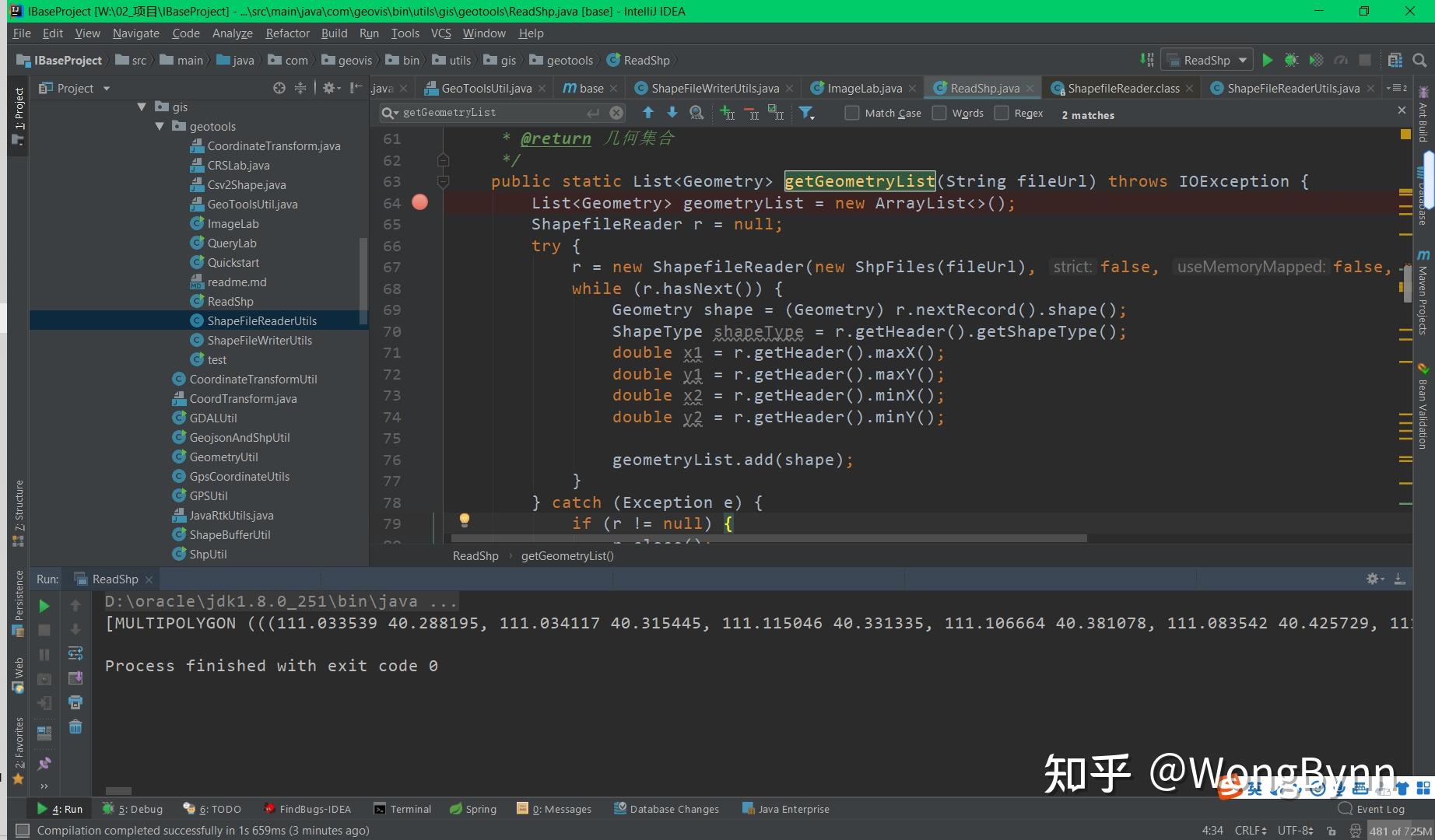
自定义GeoTools工具类
以下代码是自定义的一个
GeoTools
工具类,主要实现了一些点、线、面以及简单的空间分析的操作。
/**
* @Author:Wangb
* @Date:2021/4/14 10:33
package com.geovis.bin.utils.gis.geotools;
import com.vividsolutions.jts.geom.*;
import com.vividsolutions.jts.io.ParseException;
import com.vividsolutions.jts.io.WKBReader;
import com.vividsolutions.jts.io.WKBWriter;
import com.vividsolutions.jts.io.WKTReader;
import org.geotools.geometry.jts.JTSFactoryFinder;
import java.util.ArrayList;
import java.util.List;
public class GeoToolsUtil {
private static com.vividsolutions.jts.geom.GeometryFactory GEOMETRYFACTORY = JTSFactoryFinder.getGeometryFactory();
private static WKTReader WKTREADER = new WKTReader(GEOMETRYFACTORY);
private static WKBWriter WKBWRITER = new WKBWriter();
private static WKBReader WKBREADER = new WKBReader();
* 以下内容为几何地理实体类的wkt形式样例,供开发参考
* POINT -> POINT(108.36 34.36)
* LINESTRING -> LINRSTRING("108.36 34.36","108.37 34.37","108.37 34.37")
* POLYGON -> POLYGON((108.36 34.36,108.37 34.37,108.38 34.38,108.36 34.36))
* POLYGON -> POLYGON((108.36 34.36,108.37 34.37,108.38 34.38,108.36 34.36),(108.36 34.36,108.37 34.37,108.38 34.38,108.36 34.36))
* MULTIPOLYGON -> MULTIPOLYGON((1 1,5 1,5 5,5 1,1 1 ),(2 2,6 3,6 4,6 5,2 2),( 2 1, 3 2,3 3, 2 1))
* 面转换为线
* @param geom
* @return
public static Geometry polygon2LineString(Geometry geom) {
String geometryType = geom.getGeometryType().toUpperCase();
Geometry res;
if ("MULTIPOLYGON".equals(geometryType)) {
int geoNum = geom.getNumGeometries();
ArrayList<LineString> lineList = new ArrayList<>();
if (geoNum > 1) {
// 包含多个面,面中包含环
for (int i = 0; i < geoNum; i++) {
Polygon geo = (Polygon) geom.getGeometryN(i);
lineList.add(GEOMETRYFACTORY.createLineString(geo.getExteriorRing().getCoordinates()));
for (int j = 0; j < geo.getNumInteriorRing(); j++) {
lineList.add(GEOMETRYFACTORY.createLineString(geo.getInteriorRingN(i).getCoordinates()));
LineString[] lines = new LineString[lineList.size()];
lineList.toArray(lines);
res = GEOMETRYFACTORY.createMultiLineString(lines);
} else {
//包含一个面,面中包含环
Polygon poly = (Polygon) geom.getGeometryN(0);
lineList.add(GEOMETRYFACTORY.createLineString(poly.getExteriorRing().getCoordinates()));
for (int i = 0; i < poly.getNumInteriorRing(); i++) {
lineList.add(GEOMETRYFACTORY.createLineString(poly.getInteriorRingN(i).getCoordinates()));
LineString[] lines = new LineString[lineList.size()];
lineList.toArray(lines);
res = GEOMETRYFACTORY.createMultiLineString(lines);
} else if ("POLYGON".equals(geometryType)) {
//只包含一个面
res = GEOMETRYFACTORY.createLineString(geom.getCoordinates());
} else {
res = null;
return res;
* 计算面与线的交点
* @param geom
* @param line
* @return
public static Geometry getPointOfIntersection(Geometry geom, Geometry line) {
Geometry lines = polygon2LineString(geom);
return lines.intersection(line);
* wkt转Geometry
* @param wkt
* @return
public static Geometry wkt2Geometry(String wkt) {
GeometryFactory geometryFactory = JTSFactoryFinder.getGeometryFactory();
WKTReader wktReader = new WKTReader(geometryFactory);
Geometry geometry = null;
try {
Geometry read = wktReader.read(wkt);
return geometry;
} catch (ParseException e) {
e.printStackTrace();
return null;
* 创建一个点
* @param lon
* @param lat
* @return
public static Point creatrPoint(String lon, String lat) {
Coordinate coordinate = new Coordinate(Double.parseDouble(lon), Double.parseDouble(lat));
Point point = GEOMETRYFACTORY.createPoint(coordinate);
return point;
* 使用拼好的字符串来创建一个点
* @param coor
* @return
* @throws ParseException
public static Point creatrPoint(String coor) throws ParseException {
Point p = (Point) WKTREADER.read(coor);
return p;
* 创建一个Polygon
* @param polygon
* @return
* @throws ParseException
public static Polygon createPolygon(String polygon) throws ParseException {
Polygon p = (Polygon) WKTREADER.read(polygon);
return p;
* 使用拼接好的字符串来创建一个LineString
* @param line
* @return
* @throws ParseException
public static LineString createLineString(String line) throws ParseException {
LineString lineString = (LineString) WKTREADER.read(line);
return lineString;
* 比较两个点是否相同,
* @param p1
* @param p2
* @return
* @throws ParseException
public static boolean equalsLinePoint(String p1, String p2, int srid) throws ParseException {
Point geom1 = (Point) WKTREADER.read(p1);
geom1.setSRID(srid);
Point geom2 = (Point) WKTREADER.read(p2);
geom2.setSRID(srid);
return geom1.equals(geom2);
* 比较两个线是否相同
* @param l1
* @param l2
* @return
* @throws ParseException
public static boolean equalsLineString(String l1, String l2) throws ParseException {
LineString geom1 = (LineString) WKTREADER.read(l1);
LineString geom2 = (LineString) WKTREADER.read(l2);
return geom1.equals(geom2);
* 比较两个面是否相同
* @param p1
* @param p2
* @return
* @throws ParseException
public static boolean equalsPolygon(String p1, String p2) throws ParseException {
Polygon geom1 = (Polygon) WKTREADER.read(p1);
Polygon geom2 = (Polygon) WKTREADER.read(p2);
return geom1.equals(geom2);
* 线对象有没有交点
* @param s1
* @param s2
* @return
* @throws ParseException
public static boolean disjoinLineString(String s1, String s2) throws ParseException {
LineString line1 = (LineString) WKTREADER.read(s1);
LineString line2 = (LineString) WKTREADER.read(s2);
return line1.disjoint(line2);
* 面对象有没有交点
* @param s1
* @param s2
* @return
* @throws ParseException
public static boolean disjoinPolygon(String s1, String s2) throws ParseException {
Polygon p1 = (Polygon) WKTREADER.read(s1);
Polygon p2 = (Polygon) WKTREADER.read(s2);
return p1.disjoint(p2);
* 判断两条线是否相交
* @param s1
* @param s2
* @return
* @throws ParseException
public static boolean interSectionOfLineStringAndLineString(String s1, String s2) throws ParseException {
LineString l1 = (LineString) WKTREADER.read(s1);
LineString l2 = (LineString) WKTREADER.read(s1);
Geometry points = l1.intersection(l2);
return l1.intersects(l2);
* 判断两条线是否相交,并返回坐标数组
* 该方法为初写方法,未经实际检验
* @param s1
* @param s2
* @return
* @throws ParseException
public static Coordinate[] interSectionOfLineStringAndLineString(String s1, String s2, int srid) throws ParseException {
LineString l1 = (LineString) WKTREADER.read(s1);
LineString l2 = (LineString) WKTREADER.read(s1);
Geometry points = l1.intersection(l2);
Coordinate[] coordinates = points.getCoordinates();
return coordinates;
* point[]转Polygon
* @param s
* @return
* @throws ParseException
public static Polygon pointArray2Polygon(String s) throws ParseException {
return (Polygon) WKTREADER.read(s);
* 返回Polygon区域的点数组
* @param polygon
* @param lon
* @param lat
* @return
public static List<Point> IntersectionPointsAndPolygon(Polygon polygon, String lon, String lat) {
List<Point> points = new ArrayList<>();
Point point = creatrPoint(lon, lat);
boolean contains = polygon.contains(point);
if (contains) {
points.add(point);
return points;
* 返回Polygon区域的点数组
* @param polygon
* @param coor
* @return
public static List<Point> IntersectionPointsAndPolygon(Polygon polygon, String coor) throws ParseException {
List<Point> points = new ArrayList<>();
Point point = creatrPoint(coor);
boolean contains = polygon.contains(point);
if (contains) {
points.add(point);
return points;
* 计算两个区域的是否相交
* @param p1
* @param p2
* @return
public static boolean isIntersects(Polygon p1, Polygon p2) {
boolean flag = p1.intersects(p2);
return flag;
* 计算两个区域是否相交,并返回交叉区域
* @param p1
* @param p2
* @return
public static Polygon intersectsArea(Polygon p1, Polygon p2) {
Polygon geom = (Polygon) p1.intersection(p2);
return geom;
* 返回给定位置的缓冲区范围
* @param point
* @param range
* @return
* @throws ParseException
public static Polygon fireArea(String point, double range) throws ParseException {
Point fire = (Point) WKTREADER.read(point);
Polygon buffer = (Polygon) fire.buffer(range);
return buffer;
* 返回两个点之间的距离
* @param p1
* @param p2
* @return
public static double distanceOfPoint(Point p1, Point p2) {
return p1.distance(p2);
* 返回两个点之间的距离
* @param lon1
* @param lon2
* @param lat1
* @param lat2
* @return
public static double distanceOfPoint(String lon1, String lon2, String lat1, String lat2) {
Point p1 = creatrPoint(lon1, lat1);
Point p2 = creatrPoint(lat2, lon2);
return p1.distance(p2);
* 给定起始点、目标点和移动速度,返回机动至目标点的使用时间
* @param start
* @param end
* @param speed
* @return
public static double timeOfGoal(Coordinate start, Coordinate end, float speed) {
